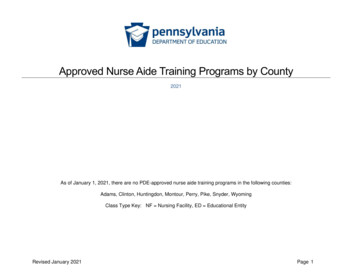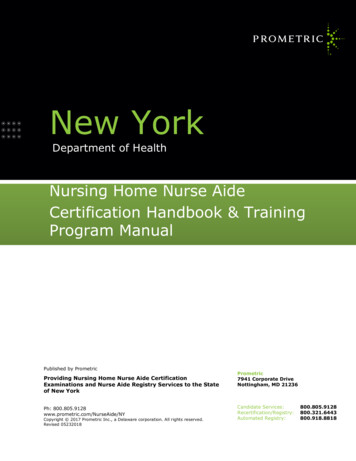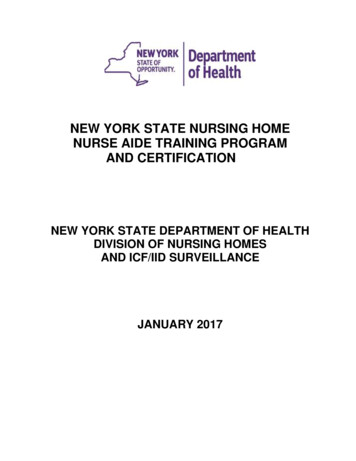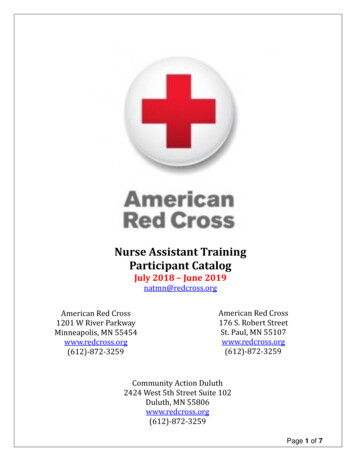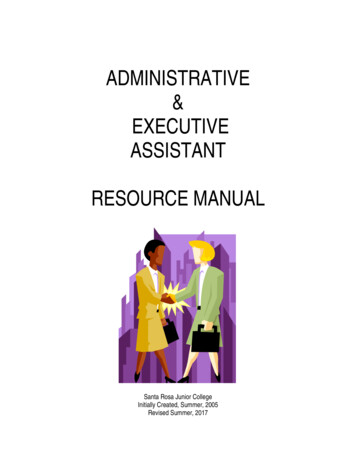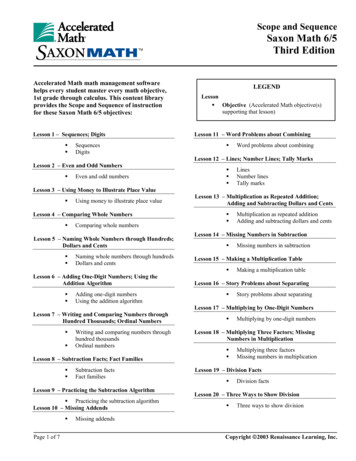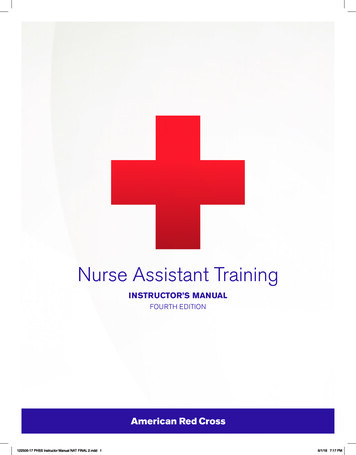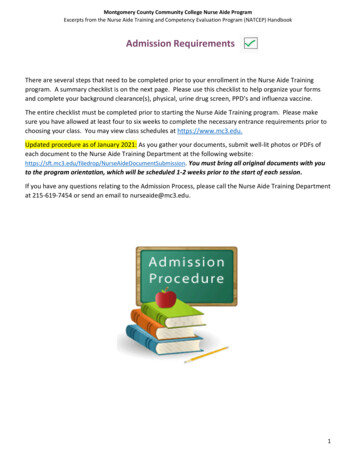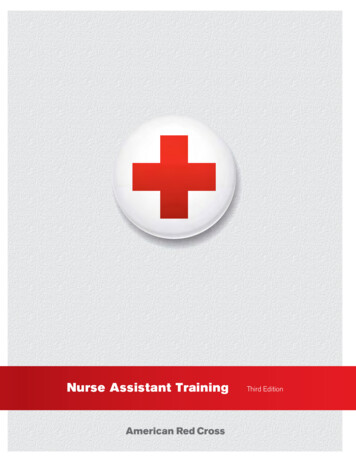
Transcription
Nurse Assistant TrainingThird Edition
PLESAMC HA P T E R11Providing RestorativeCareAfter reading this chapter, you will have the information needed to: Goals After practicing the corresponding skills, you will have the information needed to: 140 Explain the goals of restorative care.Describe the nurse assistant’s role in providing restorative care.Promote independence and self-care.Help a person to be active.Help a person walk with and without a cane, crutches and a walker.Help a person with passive range-of-motion exercises. Nurse Assistant Training
Key Terms:restorative care(rehabilitation n exercisestransfer (gait) beltimmobilitywork. However, if you work in a facility that receivesMedicare funding, providing restorative care is aparticularly important part of your job. To meet OmnibusBudget Reconciliation Act (OBRA) requirements, thehealth care staff must identify each person’s risk factors forfunctional decline (loss of abilities), and take appropriatesteps to maintain the person’s existing abilities and preventany future loss of abilities from occurring. Providingrestorative care is essential to achieving these goals.SAMPLEToday you arrive for your shift at MorningsideNursing Home promptly at 6:45 a.m. After clockingin and putting your personal belongings in yourlocker, you report to the supervising nurse to find outwhich residents you will be caring for today. Your firstresponsibility will be to help your residents with earlymorning care in preparation for breakfast. You decideto start with Mrs. Winnie Steele and Mrs. DorothyWinesap, roommates in Room 120. Mrs. Steele, whois 72 years old, has chronic heart failure. Because herweak and damaged heart struggles to pump oxygenrich blood throughout her body, Mrs. Steele becomestired and short of breath very easily. As a result, shemust stop what she is doing frequently to rest andcatch her breath. However, you know that Mrs. Steelecan do a great deal for herself if she is allowed to takeher time and go at her own pace. Mrs. Winesap, herroommate, fell and broke her hip just after her 95thbirthday. Mrs. Winesap is not allowed to stand up andbear weight on her hip for several more weeks;as a result, she requires a great deal of assistance withtoileting and dressing. After greeting the roommatesand helping Mrs. Steele into the bathroom so that shecan use the toilet and brush her teeth, you turn yourattention to helping Mrs. Winesap use a fracture pan(a special type of bedpan often used for people withbroken hips). In this way, while you are helpingMrs. Winesap, you can still keep an eye on Mrs. Steeleand be available to offer assistance if she needs it.GOALS OF RESTORATIVE CAREThe people in your care require nursing care becausethey are ill, injured or very frail. Because of physicaldisability, mental disability or both, their ability to care forthemselves is decreased. One of the primary goals ofthe nursing staff is to help people maintain the abilitiesthey still have, and to help them regain (to the greatestextent possible) the abilities they have lost. This kind ofcaregiving is called restorative care or rehabilitationnursing. Restorative care helps a person become asfully functional and independent as possible, whichincreases the person’s ability to enjoy life.Practicing the principles of restorative care is importantwith all of the people in your care, no matter where youTHE NURSE ASSISTANT’SROLE IN PROVIDINGRESTORATIVE CARERestorative care is primarily carried out by the nursingstaff. As a nurse assistant, you play a critical role inproviding restorative care. This is a very important andessential part of your job, because you are the memberof the health care team who will spend the most timewith the person each day. As you carry out your dailyresponsibilities, you will provide restorative care byencouraging and helping the person to do as much forherself as she is able, and by providing care accordingto the person’s care plan (Figure 11-1). Much of thephysical care you provide, such as repositioning peopleand helping them to get out of bed and walk, is essentialfor helping the people in your care to maintain or regaintheir physical health, strength and abilities. In addition,when you encourage a person to do something for himself(instead of just doing it for him), you help to maintainthe person’s physical abilities as well as his sense ofindependence, which is important for the person’s dignityand emotional health.Some of the people in your care will need to learn newways to do old things so that they can do as much forthemselves as possible. Another important aspect ofproviding restorative care is encouraging and helpingthose in your care to practice these new skills. Often,the person will work with other members of the healthcare team (such as a physical therapist, occupationaltherapist or speech therapist) to learn these new skills,but you will be responsible for helping the person topractice the skills on an ongoing basis (Figure 11-2).For example, a physical therapist may teach a personhow to walk with a walker, but you will be responsible forencouraging the person to use the walker, and makingsure that she is using the walker correctly.Chapter 11 Providing Restorative Care 141
PLEFigure 11-2 Nurse assistants help the people in their care to practicenew skills that they are learning in therapy.Figure 11-1 Enabling the resident by ensuring that her cane is withinreach gives her the power to be more independent.SAMSeeing positive results from restorative care can takea long time. A key part of your job is observing andreporting even the smallest changes in a person’sabilities. What you observe depends on the goals thatare written in the person’s care plan. You may have towatch to see how far the person walks, how much sheeats or how far she can bend a joint. It is important tonote changes in the person’s abilities in measurableterms, such as distance, amount, or length of time. Alsotake note of how much effort it took for the person tocomplete the task. Listen to the person’s comments,and observe physical signs, such as sweating, difficultycatching the breath, or the number of times the personmust stop and rest before continuing. Always rememberto report and record the restorative care that youprovide, and your observations about the person’sprogress or setbacks. This information helps the otherhealth care team members adjust the person’s care planas necessary. In facilities that receive Medicare funding,accurate documentation is also essential for ensuringthat the person continues to be eligible for therapy andother services as needed, and that the facility receivesproper reimbursement for the services provided.Box 11-1Nurse AssistantGuidelines for providing restorative care are given inBox 11-1.PROMOTING INDEPENDENCEHelping a person to keep or achieve his best levelof independence is an important goal of restorativeDO’s and DON’TsProviding Restorative CareDO follow the person’s care plan.DO help the person set realistic goals.DO recognize what the person can do for DON’T offer false encouragement, orherself, and encourage her to do it.compare the person to others. Eachperson is an individual.DO emphasize the person’s abilities,rather than her disabilities.DO be patient.DO focus on the whole person, not justthe affected part of her body. Considerthe person’s emotional needs as well asher physical ones.142 DO recognize and celebrate even thesmallest successes.DO ask the therapist or nurse to showyou how to best help the person practicenew skills or use new assistive devicescorrectly.DON’T rush the person through tasks.DO report and record the restorativeGive the person enough time to completecare you provide and your observationsthe task independently.regarding the person’s abilities, usingmeasurable terms. Nurse Assistant Training
PLEcare. Remember that promoting independence isone of the five principles of care. Think about how itwould make you feel to have to depend on anotherperson to help you with routine activities, like dressing,eating or bathing. Would you feel like a burden? Wouldyou feel ashamed that you need help doing thingsthat other people are able to do easily on their own?Would it frustrate you to have to arrange your schedulearound when someone else is available to help you?Most people, even people who are ill, injured or elderly,have an emotional need to do as much for themselvesas possible, for as long as possible. The ability to actindependently is important for a person’s self-esteemand sense of dignity. Doing things for oneself is alsoimportant for a person’s physical health. Activitystrengthens and inactivity weakens.SAMAs a nurse assistant, you will help to promoteindependence by allowing the people in your care toprovide for their own personal care as much as they areable (Figure 11-3). By encouraging the person to do asmuch for himself as possible, you help increase his selfesteem and sense of purpose. Explain what you want theperson to do in a way that he can understand, and reviewthe steps if necessary. Make sure the person has thesupplies he needs to complete the task. Many people useassistive devices to make it easier for them to completecertain tasks independently (Figure 11-4). If the personuses an assistive device for a certain task, make sure it iswithin reach. Reassure the person that you are availableto help if necessary, but encourage him to do as much forhimself as possible. Remember to be patient. The personwill require more time to complete the task and may needto try several times before successfully completing a step.Resist the urge to complete the task for the person. It isbetter to allow him the opportunity to succeed and feelthe sense of accomplishment that comes with success.Of course, if the person is becoming very frustratedor seems overly exhausted, it is appropriate to step inand help him to complete the task. Always notice andcomment on small successes. If you say, “Mr. Lightfoot,you were able to eat everything on your tray but desserttoday, and last week you could only get halfway throughyour meal before getting tired!” he will probably want totry to eat the entire meal without any help by next week.Sharing your observations about the progress he hasmade encourages him to keep trying to improve.Many of the people in your care will be receiving therapyto learn new skills to help increase their independence.For example, the occupational therapist may teach theperson how to use an assistive device for eating, or thephysical therapist may teach the person how to use anassistive device for walking. You continue that teachingby encouraging the person to use her new skills, and bymaking sure that she is performing the skills correctly.Prompting is a communication technique that can beFigure 11-3 An important part of providing restorative care is helpingthe person to be as independent as possible. This man can shavehimself if someone brings him the necessary supplies.Eating DevicesGrooming and Dressing DevicesWalking DevicesFigure 11-4 Assistive devices can help people remain independent.used to remind a person what to do without actuallytelling her. If a person hesitates to do something that youknow she can do, it is better to prompt her than to do itfor her. For example, suppose a person is about to standup by herself and use her walker. The walker should bein front of her when she stands up, but it is to the leftof where she is going to stand. By asking the person ifher walker is where she wants it, you remind her that itis not in the right place and give her the chance to movethe walker into the correct position before proceeding. Ifthe person seems to get stuck while completing the taskand gives you a questioning look, do not assume thatthe person does not know what to do. She may just beworried about doing the task incorrectly in front of you.Help by asking, “What do you think you should do next?”The person may tell you and then go on with the task.If necessary, tell her what step should come next, butencourage her to complete the task independently.Chapter 11 Providing Restorative Care 143
how much you were able to accomplish on your owntoday! I hardly had to help you at all!” Mrs. Steele looksup at you and smiles weakly. She says, “I’ve done thingsfor myself my whole life. I don’t want to stop now.”Although Mrs. Steele tires very easily, she likesto choose her own clothes and dress herself as muchas possible. Today, Mrs. Steele has selected a pair ofslacks, a sweater set and a necklace. She has put onher slacks and the short-sleeved sweater, but she ishaving trouble with the cardigan. She is sitting on theedge of the bed and is clearly very tired. It has taken alot of energy for her to use the toilet, brush her teeth,choose her outfit and begin dressing. You are almostfinished helping Mrs. Winesap when Mrs. Steele says,“Honey, would you be a sweetheart and just help mewith these sleeves?” You are almost finished in Room120 and would like to finish helping your other fourassigned residents get ready for breakfast. You knowthat the easiest and quickest thing to do would bejust to finish dressing Mrs. Steele in her cardigan, butinstead, you say, “Of course! Here, let me help you.”You hold up the cardigan for her and ask her to putone arm in. Before continuing with the other arm,Mrs. Steele needs to stop and rest, but after about aminute she is able to put her other arm in the sleeve.Then you fasten her necklace for her and help her toapply lipstick. You say, “Mrs. Steele, I’m so proud ofPLENurse assistants are taught to always putthe client first. By allowing Mrs. Steele tocomplete most of her personal care by herselfwhile you helped Mrs. Winesap, did youneglect your responsibilities towardMrs. Steele? Why or why not?You decided to help Mrs. Steele finish puttingon her cardigan herself, instead of justputting the cardigan on her. Was the extratime it took to help Mrs. Steele put on thecardigan herself worth it? Why or why not?Mrs. Steele’s condition, heart failure, isterminal (that is, it cannot be cured, andeventually, it will probably cause herdeath). Do you think it is important toprovide restorative care for a person whohas a terminal condition? Why or why not?addition, the ability to move is important for our physicaland emotional health.Another major goal of restorative care is helping theperson to maintain or achieve her best level of mobility.If we cannot move, it becomes much more difficult todo things for ourselves and to remain independent. InHave you ever heard the expression “Use it or loseit”? This condition really can happen. Immobility, orthe state of not moving, can cause many physical andemotional problems (Figure 11-5). For example:SAMPROMOTING MOBILITYFigure 11-5 Immobility can cause physical and emotional problems.144 Nurse Assistant TrainingContinued on page 146
Table 11-1 Assistive Devices for WalkingAssistive DeviceUsed ByGuidelines forProper UseThe top of the walker frameshould be even with theperson’s hip bones. WalkerMake sure the walker is directly in frontof the person.Make sure the person places his handson the walker’s handgrips, stands erectand slightly flexes his elbows.{ Pick-up walker: Have the personlift the walker and put it down about6 inches forward and then step or hopinto it.{ Four-wheeled or semi-wheeledwalker: Have the person roll thewalker forward about 6 inches andthen step into it.Encourage the person to walk normally,looking ahead, while using the walker.PLEA person who canbear weight butneeds support onboth sidesEnsuringProper FitA person whoneeds assistancewith balance but isable to walk withoutmuch difficultyThe top of the cane shouldbe even with the person’ship bone. SAM CaneA person whocannot use one legor when both legsare weak and needsupport The top of the crutchesshould rest against theperson’s sides (not in theperson’s armpits). Make sure the person holds the canehandle with the hand opposite the weakleg and stands erect, with his elbowslightly flexed.Position yourself on the person’sweaker side.Have the person move the cane forwardabout 6 to 11 inches. Make sure the tipof the cane is firmly on the floor.Have the person use the cane forsupport while standing on the strongerside and moving the weaker leg forwarduntil it is even with the cane. Next, theperson moves the stronger leg forward,ahead of the cane and the weaker leg.Encourage the person to look aheadwhile using the cane.Make sure the person stands erect,supporting his weight on the handgripsand gripping the crutches betweenthe chest and the inside of theupper arms.Have the person move bothcrutches forward along with theweaker leg, and then bring thestrong leg up to meet thecrutches.Encourage the person to look aheadwhile using the crutches.CrutchesChapter 11 Providing Restorative Care 145
does not pass after several minutes, help the personto lie back down and report the dizziness to the nurse.The person may also become dizzy after she has beenwalking for awhile. If this occurs, or if the personbecomes sweaty, short of breath or complains ofpain, help her to sit down and rest. Some peoplemay begin to fall quite suddenly while they arewalking, especially if they are weak, ill or unsteadyon their feet. Do not try to stop a fall; doing somay injure you and the person. Instead, usethe technique shown in Box 11-2 to minimizeinjury to the person and to yourself if the personbegins to fall while you are assisting herwith walking.A transfer (gait) belt is a wide, webbed belt thatis placed around the person’s waist when you areassisting the person to walk. The transfer belt allowsyou to support the person by giving you a safeplace to put your hands (Figure 11-6). Manyemployers will require you to use a transferbelt when helping a person to stand, walk ortransfer (for example, from the bed to a chair),unless the person has a medical condition thatmakes using a transfer belt unsafe. A transfer beltshould not be used for people with certain medicalconditions, including recent abdominal, chest orback surgery; severe respiratory problems; or severecardiac problems. When putting a transfer belt on aperson, make sure that it is snug without being tootight. You should be able to slip two fingers betweenthe person’s body and the belt.SAM Musculoskeletal problems. Bones losecalcium and become brittle. Muscle massdecreases (a condition called atrophy), andstrength is lost. Holding a joint in the sameposition for too long can cause the tendons toshorten and become stiff, resulting in loss ofmotion in the joint. This is called a contracture.Bend your wrist so that your palm moves towardthe inside of your arm. This position is similar tothat of a contracture that affects the wrist. Imaginewhat it would be like to try to eat, dress and go tothe bathroom with your hand bent in this position.Respiratory problems. Lying down for longperiods of time decreases the person’s ability tofully inflate the lungs with each breath, which allowssecretions to pool in the lungs and puts the personat risk for pneumonia.Cardiovascular problems. Inactivity slowscirculation. As a result, healing is delayed anddangerous blood clots can form.Skin problems. Pressure ulcers can develop.Pressure ulcers are painful, difficult-to-heal soresthat can be fatal. You will learn more about pressureulcers in Chapter 12.Elimination problems. A lack of activity causesfood to move more slowly through the intestines,putting the person at risk for constipation. Immobilitycan also lead to incontinence (an inability to controlthe release of urine or feces).Emotional problems. Depression andfeelings of helplessness, anger and lonelinesscan occur.PLE As a nurse assistant, you help a person stay active andmobile with ambulation (walking) and range-of-motionexercises (exercises that help to keep joints functional bymoving them in a systematic way).Guidelines for helping a person to walk safely are givenin Box 11-3. Skill 11-1 describes step by step how tohelp a person to walk.Helping a Person to WalkEncouraging the people in your care who can walk todo so several times a day has many important healthbenefits, even if the person only goes a short distanceat a time. Some people will only need your assistanceto remain safe and steady on their feet while they arewalking. Others will use an assistive device, such as acane, a walker or crutches, to walk (Table 11-1). Formany people, the use of an assistive device allows theperson to walk independently.Dizziness is common when a person sits up afterbeing in bed for awhile. Before assisting a personto walk, allow her to sit on the edge of the bed forseveral minutes before standing up. If the dizziness146 Nurse Assistant TrainingFigure 11-6 A transfer belt gives you a safe place to grasp whenhelping a person to stand up and move from one place to another.
PLE Box 11-2 Minimizing Injury When a Person Starts to Fall While WalkingBend your knees and lower the person slowly to the floor bysliding him down your leg.Place one foot behind the other to widen your base of support.Lower yourself to the floor and sit beside the person. Call forhelp. While waiting for help to arrive, stay with the person.Provide reassurance and make the person comfortable.SAMPut your arms around the person’s waist or under his arms,and hug the person’s torso close to your body.Box 11-3Nurse AssistantDO’s and DON’TsHelping a Person to WalkDO make sure the person is wearingfootwear. The person’s shoes orslippers should fit well and havenonskid soles.DO use a transfer belt, unless the personhas a condition that makes the use ofa transfer belt dangerous (for example,recent abdominal, chest or back surgery;severe respiratory problems; or severecardiac problems).DON’T hold onto the person’s arm.Instead, grasp the transfer belt.DO allow the person to sit on the edgeof the bed for several minutes beforestanding up to walk, if the person hasbeen lying down in bed.DO handle medical equipment,such as an IV bag and tubing or aurinary catheter drainage bag andtubing, appropriately so that treatmentis not disrupted and the person is notharmed as you help her walk. An IVbag should always be higher thanthe IV entry site. A urinary catheterdrainage bag and tubing shouldalways be lower than the bladder.Make sure tubing is properlysecured so that it does not becomea tripping hazard.DO make sure you know the proper wayto use the person’s assistive devicefor walking, if the person uses one.Watch the person’s technique andcorrect any errors.DO make sure the assistive device is ingood working order. Rubber tips on canes,crutches or walkers that are missing, wornor cracked should be replaced. Frames onwalkers should be secure.DO watch the person carefully for signsof fatigue, dizziness or pain.DO gradually increase the distance theperson walks to help build confidence.Chapter 11 Providing Restorative Care 147
Table 11-2 Common Medical Terms Used To Describe ingAbductionMoving away from the bodyAdductionMoving toward the bodyRotationMoving in a circular motion along afixed point or axisPronationTurning the palm downwardSupinationTurning the palm upwardSAMPLETerm148 Radial DeviationBending the wrist toward the thumb(the side where the radius bone islocated)Ulnar DeviationBending the wrist toward the littlefinger (the side where the ulna bone islocated)DorsiflexionBending the ankle so that the toespoint upPlantar FlexionBending the ankle so that the toespoint downInversionTurning the ankle inwardEversionTurning the ankle outward Nurse Assistant Training
Box 11-4Nurse AssistantDO’s and DON’TsAssisting with Range-of-Motion ExercisesDO follow the person’s care plan, andexercise only the joints specified on thecare plan.DO work in a systematic manner.DO support the joint during the movement.DO pay attention to verbal and nonverbalexpressions of pain. If the person haspain, stop the movement and report yourobservations to the nurse.DON’T move the joint further than theperson can tolerate.PLEDO use good body mechanics.DO move each joint slowly, gentlyand smoothly.While you are helping Mrs. Winesap with herearly morning care, she says to you, “I am so tiredof lying in this bed all day! I can’t wait until I’m ableto be up and on my feet again!” You know that Mrs.Winesap is not allowed to bear weight on her healinghip right now, but later on in her recovery she willbegin to walk again using an assistive device.Once Mrs. Winesap’s doctor has approveda change to weight-bearing status, whichassistive device for walking would you expectthe physical therapist to recommend forMrs. Winesap?SAMWhen Mrs. Winesap has progressed enoughin therapy to walk without the physicaltherapist present, what will you look forwhen you are helping her to use the assistivedevice to ensure that she is safe and using thedevice properly?Helping a Person withRange-of-Motion ExercisesTo remain functional, joints must be used and put throughtheir normal range of motion. Normally, the activities wedo every day are enough to keep our joints healthy andfunctioning well. However, when a person has an injury orcondition that prevents normal activity, range-of-motionexercises may be used to keep the joints flexible andmobile. Range-of-motion exercises put the joint throughits maximal extent of movement (that is, the joint’s rangeof motion) and are important for preventing contracturesfrom developing. Common medical terms used todescribe movement are defined in Table 11-2.Range-of-motion exercises may be active (doneindependently by the person), active-assisted (doneby the person with help from a caregiver), or passive(done by a caregiver for the person). When you arehelping a person with range-of-motion exercises, youshould only move the joint as far as is comfortable forthe person. Be aware that range of motion differs fromperson to person. It may even differ within the sameperson, depending on the time of day. For example, aperson who has arthritis may not have much range ofmotion in the early morning because of joint pain.But in the late morning, after her bath and after shehas taken her pain medication, she may have morerange of motion.Range-of-motion exercises may be ordered for onejoint, several joints or all joints. Always check theperson’s care plan. When assisting a person withrange-of-motion exercises, work in a systematic manner,beginning at the top of the person’s body and workingyour way down. Do all of the exercises on one sideof the body, and then repeat them on the other side.Box 11-4 contains general guidelines for assisting aperson with range-of-motion exercises, and Skill 11-2provides step-by-step instructions for assisting withpassive range-of-motion exercises.CHECK YOUR UNDERSTANDINGQuestions for Review1. The nursing staff provides what kind of careto help people maintain or achieve their bestpossible level of functioning?a.b.c.d.Physical therapyOccupational therapyRestorative carePersonal careChapter 11 Providing Restorative Care 149
2.A stroke has made it difficult, but notimpossible, for Mrs. Klein to feed herself. To bestassist Mrs. Klein, you would:Feed Mrs. Klein yourself so that her food doesnot get cold.b. Place Mrs. Klein’s meal tray on her over-bedtable, and then leave the room.c. Let Mrs. Klein feed herself for 5 minutes, andthen finish feeding her the rest of the meal.d. Encourage Mrs. Klein to use the assistivedevice the occupational therapist gave to herfor eating.3. Inactivity can cause:a.b.c.d.Atrophied muscles.Blindness.Arthritis.All of the above.7. As part of providing restorative care, nurseassistants are responsible for which of thefollowing?a.Helping the person practice what he or she hasbeen taught in therapyb. Providing support and encouragementc. Reporting and recording the restorative carethat was provided and what the person was ableto achieve, using measurable termsd. All of the abovePLEa.c. A transfer beltd. A wheeled walker8. Which of the following people is a candidate forreceiving restorative care?a.Mrs. O’Leary, who is 98 years oldand blindb. Mr. Dunlap, who has had several toes amputated(surgically removed) due to complications ofdiabetesc. Mrs. Singer, who has multiple sclerosis, aprogressive neurologic disease with no cured. All of the above4. Mrs. Clymer has arthritis and needs to dorange-of-motion exercises. When you go to herroom to help her, she says that she cannot dothem today because she hurts too much. Thebest way to respond is to say:“You need to do them because the doctor orderedthem. Let’s just do them and get them over with.”b. “If we do them quickly, we’ll finish up faster.”c. “Okay, we’ll do them tomorrow.”d. “It’s so important for you to do these exercisesto keep your joints flexible. Let’s try to do themvery slowly, and you can let me know when youneed to rest or stop.”9. Mrs. Garcia, who is recovering from a broken hip,is upset because she couldn’t reach the end ofthe hallway today. “Yesterday I walked twice asfar with this stupid thing!” she says, and angrilypushes her walker away. What can you say tohelp her feel better?SAMa.5. You are helping Mr. Grey to walk to the bathroomwhen he suddenly starts to fall. What shouldyou do?a. Grab Mr. Grey’s arm to keep him from falling.b. Assist Mr. Grey to sit in a chair or on the floor.c. Hug Mr. Grey’s body close to yours and use goodbody mechanics to lower him gently to the floor.d. Call for the nurse so that she can checkMr. Grey for injuries.6. Mrs. Ward has emphysema, a lung disease thatmakes it difficult for her to breathe. As a result, shebecomes winded and tired very easily. To makeit easier for her to walk and to help her maintainher current level of independence, the physicaltherapist has recommended that she use anassistive device for walking. Which type of assistivedevice would be most appropriate for Mrs. Ward?a. Crut
THE NURSE ASSISTANT’S ROLE IN PROVIDING RESTORATIVE CARE Restorative care is primarily carried out by the nursing staff. As a nurse assistant, you play a critical role in providing restorative care. This is a very important and essential part of your job, because you are the member of the health care team who will spend the most timeFile Size: 1MB
